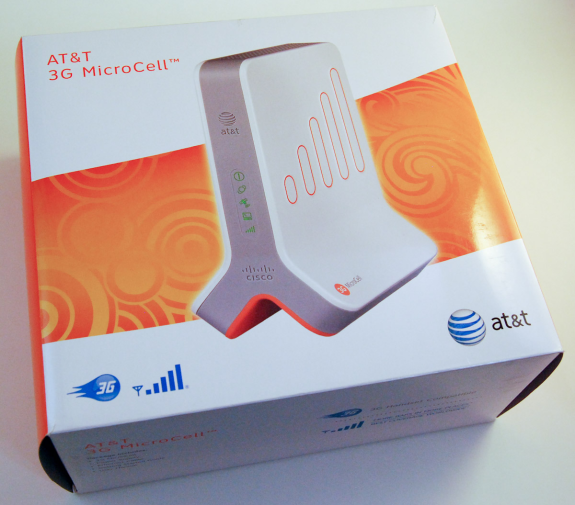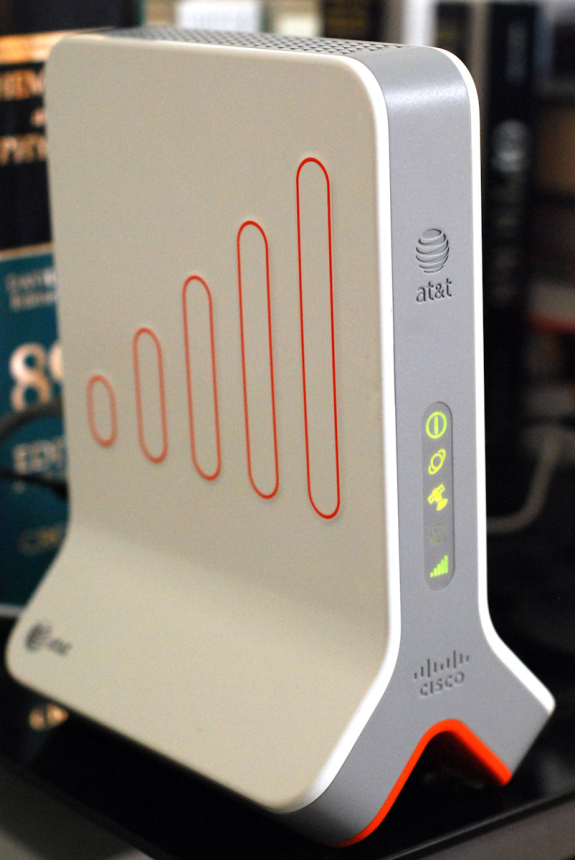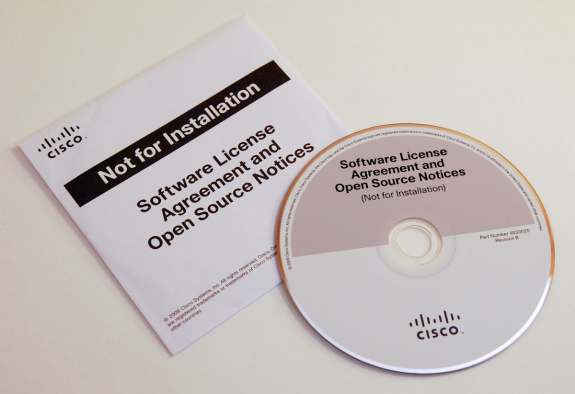AT&T 3G MicroCell: A Comprehensive Exploration
by Brian Klug on April 1, 2010 1:55 AM EST- Posted in
- Smartphones
- AT&T
- Microcell Review
- Mobile
Inside is just about everything you'd expect. There's a standard quick getting started guide if you're reading-challenged, an equally straightforward but more hefty users manual, power supply, and a yellow ethernet cable. Then there's the device itself, bearing Cisco branding and AT&T logos. On its front are five status LEDs: power, ethernet, GPS, computer, and 3G cellular.
The "computer" status LED is interesting - Cisco suggests connecting the microcell in-line with your internet connection, before your router in what they call a "priority mode" configuration. This makes sense, as it offers an easy connection method for users that either don't know about QoS, NAT, or port forwarding, or aren't competent enough to configure them. I didn't investigate priority mode in much detail, instead using QoS and port forwarding rules of my own, but more on that later.
Powered up and running - your very own "cancer box"
On the back are two ethernet ports. The yellow one is what we're interested in, as this is the primary connection for internet. The black one is labeled "computer," and as noted earlier and is for connecting another device behind and in line with the microcell - ostensibly a router or your computer if you lack one. There's also an antenna jack for connecting an external GPS antenna if you can't install the device near a window, or if your windows have a coating which attenuates GPS frequencies. AT&T offers absolutely no guidance of any kind about what type of port this is, but from experience it appears to be MMCX or possibly RP-MMCX. There's also a reset pin hole and power adapter.
Backside of the AT&T MicroCell
Interestingly, there's also an open source license agreement notice CD and sleeve. I half expected a complete dump of all the relevant code given the CD, but instead of Cisco effectively using the 700 MB of storage, they parked one 591 kilobyte, 281 page long PDF document with all the FOSS licenses for packages used on the MicroCell. No, I'm not even joking, this CD literally has one half megabyte file on it. What's even more hilarious is that the file is actually linked for download during the registration process, which makes a heck of a lot more sense.
Not for installation - for reading during that long activation process
Of course, for your amusement, I went through the whole document and extracted all the open source packages cited. There are 24 licensed pieces of software, but the takeaway is that the femtocell is running BusyBox 1.8.2. Ostensibly, most of the code is being used for routing packets through what amounts to a router when you've put the device in "priority mode," but as we'll discover later there's plenty more going on too.














63 Comments
View All Comments
A beautiful mind - Thursday, April 1, 2010 - link
My Nokia N900 already uses the home/office wifi connection to access the internet, with the possibility to receive/make calls from/to skype.There is absolutely no extra functionality that is provided by the femtocell approach.
softdrinkviking - Thursday, April 1, 2010 - link
For you and me, this is true.But not for everyone.
That's the really sad thing about this device. It's designed as a way to nickel and dime poor souls whose homes are in a dead zone and absolutely have to answer their phone for business.
nafhan - Thursday, April 1, 2010 - link
Great article, and you did an excellent job of diving into the tech behind the femtocell.An interesting follow up to this article might be to see what kind of results you get from purchasing an antenna and repeater. I've seen antenna/repeater setups online in the $350 and up range, and wondered how they would do. If they work OK, it might be a viable alternative, especially for people without good internet connections.
gwolfman - Thursday, April 1, 2010 - link
Where is the print article feature on the new site?Maroon - Thursday, April 1, 2010 - link
They've been sneaking these things in Apple stores. No wonder the iPhone feelgood only lasts untill you get out of the store and have to rely on the "standard" AT&T network. LOL.soccerharms - Thursday, April 1, 2010 - link
Are you kiddin' me? I am going to approach this from two angles. The first being that this article is completely fake. ITS APRIL 1st people! The tech community should have an uproar for such a device. We buy internet and it is usually our responsibility to distribute it around the house with a router for wireless and whatnot. HOWEVER, we do not buy a wireless......phone plan with the intention on increasing a carriers crappy signal in our own house out of our pocket. That's ludacris! There is another much cheaper solution...........its called a LAN line with a cordless phone HA!The only company that could profit from a device like this would be Apple. But they would have to make it a little more shiney and put that quarter eaten logo on the side :)
Let the battles begin....
Jaybus - Thursday, April 1, 2010 - link
This is like buying an airline ticket only to find there is no flight. Since they don't have a flight, the airline offers to sell you your own airplane. You have to provide your own pilot, fuel, and maintenance, but you still have to pay them the full price for a ticket whenever you fly your own airplane. So my idea is to start a car rental business that has no cars. Anyone willing to pay AT&T for a microcell that uses their own Internet connection would surely be willing to pay me a rental fee for driving their own car.HotFoot - Thursday, April 1, 2010 - link
Eh... much of this market is iPhone users - people already willing to accept the concept of ecosystem lock-in. By a similar analogy to your car rental company, they're already willing to buy a car from a company that requires that they drive only on roads built or approved by that company, buy gas only at that company's stations, and buy car insurance from that company.Why not charge them for the roadside delivery of a jerry can of gas when the customer finds out the station filled their tank with water instead of fuel?
yacoub - Thursday, April 1, 2010 - link
I give it a year or two before the first cancer danger report comes out. ;)loydcase - Thursday, April 1, 2010 - link
AT&T cell reception at my house is weak in spots. OTOH, if a femtocell allows me to rip out my landlines, it might be worth it. So I'd like to know if a femtocell would be viable for that purpose.